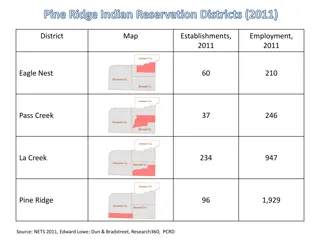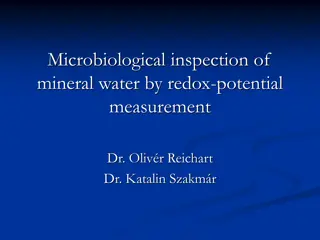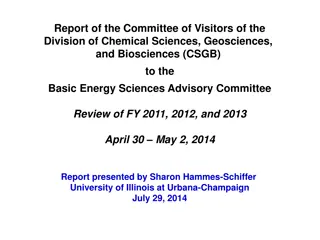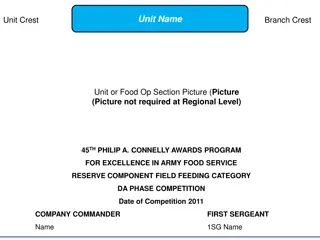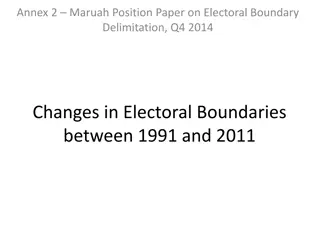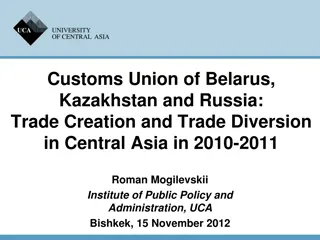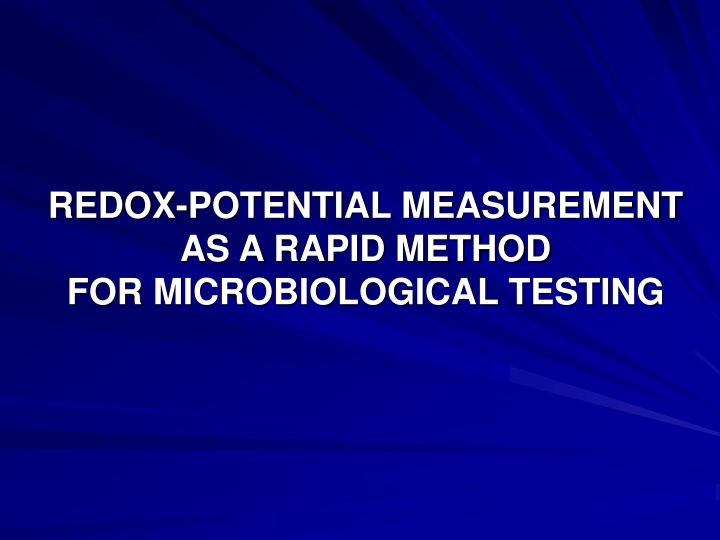
Redox Potential Measurement in Microbiological Testing
Explore the significance of redox potential measurement as a rapid method for microbiological testing. Learn about the challenges in traditional testing methods, the principles of redox-potential measurement, and its application in biological systems. Discover how the Nernst equation and test cells are utilized for accurate measurements and interpreting microbial growth curves based on Eh values.
Download Presentation

Please find below an Image/Link to download the presentation.
The content on the website is provided AS IS for your information and personal use only. It may not be sold, licensed, or shared on other websites without obtaining consent from the author. If you encounter any issues during the download, it is possible that the publisher has removed the file from their server.
You are allowed to download the files provided on this website for personal or commercial use, subject to the condition that they are used lawfully. All files are the property of their respective owners.
The content on the website is provided AS IS for your information and personal use only. It may not be sold, licensed, or shared on other websites without obtaining consent from the author.
E N D
Presentation Transcript
REDOX-POTENTIAL MEASUREMENT AS A RAPID METHOD FOR MICROBIOLOGICAL TESTING
Problems in microbiological quality control Classical methods Long incubation time (1-4 days) The applicability, reliability and test price of the methods are concentration-depending: High concentration: dilution and colony counting in the range of 30-300 cfu/ml. Low concentration: MPN method Membrane filtering
Redox-potential measurement Physico-chemical base Assuming a chemical reaction: a A + b B c C + d D [C]c[D]d Q = ------------ [A]a[B]b
Free energy and electric work G = G + R T ln Q G = - n F E. n F E = - n F E + R T ln Q
Electromotive force R T [C]c[D]d E = E - ------- ln --------- n F [A]a[B]b
In biological systems The energy source of the growth is the biological oxidation which results in a reduction in the environment. This is due to the oxygen depletion and the production of reducing compounds in the nutrient medium. A typical oxidation-reduction reaction in biological systems: [Oxidant] + [H+] + n e- [Reductant]
The electric effect of the changing could be expressed by the Nernst equation: RT [oxidant] [H+] Eh= E0+ ------ ln ---------------- nF [reductant] RT [reductant] Eh= E0- ------ ln ---------------- nF [oxidant] [H+] Where Ehis the redox-potential referring to the normal hydrogen electrode (V) E0 is the normal redox-potential of the system (V) R is the Gas-constant F is the Faraday constant F = 9.648 104C/mol (J/V mol) n is the number of electrons in the redox system (n=1) R = 8.314 J/mol K
Test cell for redox potential measurement
Typical redox-curve of the microbial growth Eh lg N E. coli 37 C, TSB 500 9 400 8 300 |dE/dt|>DC 200 7 lg Nc Eh (mV) 100 lg N 6 0 -100 5 -200 4 -300 TTD lg N0 -400 3 0 1 2 3 4 5 6 7 8 9 t (h)
The detection time (TTD) is that moment when the absolute value of the rate of redox potential change in the measuring-cell overcomes a value which is significantly differing from the random changes (e.g. |dE/dt| 0.5 mV/min). This value is the detection criterion. As the critical rate of the redox potential decrease needs a determined cell count the detection time depends on the initial microbial count.
Redox-curves of several bacteria 500 400 300 200 Eh (mV) 100 0 -100 -200 -300 -400 0 5 10 15 20 t (h) Campylobacter Ent. faecalis B. subtilis Ps. aeruginosa L. monocytogenes E. coli
Effect of the initial Cell- concentration on the redox-curves E. coli in TSB 400 300 200 100 Eh (mV) 0 -100 -200 -300 -400 0 60 120 180 240 300 360 420 480 540 600 660 720 780 840 900 960 t (min) Steril lgN=3,39 steril lgN=4,25 lgN=0,09 lgN=4,80 lgN=2,38 TTD for the redox-potential measurement is: | E/ t|>1mV/min
Effect of the initial cell concentration on TTD E. coli in TSB 6 5 4 TTD (h) 3 2 1 0 2 3 4 5 6 lgNo (cfu/inoculum)
Determination of calibration curves 1. External calibration curve Known microflora The equation of the calibration curve is calculated by linear regression from the log N (determined by classical cultivation) and the TTD (is determined instrumentally)
Determination of calibration curves 2. Internal calibration curve Unknown microflora This method is applied when the composition of the microflora is not known and previously constructed calibration curve cannot be taken. In this case, the redox potential measurement is combined with the MPN method. Based on the last dilution levels still showing multiplication, the initial viable count is calculated using the MPN-table. Based on the obtained microbe count and TTD values, the internal calibration curve can be constructed.
Determination of the internal calibration curve 1.
Determination of the internal calibration curve 2.
Determination of the internal calibration curve 3.
Validation of the Redox-potential measuring method
Test microorganisms and culture media of the tests1. Microorganisms Redox potential BBL, TSB TSA, Tergitol BBL, TSB TSA, Tergitol Plate counting Escherichia coli Enterobacter aerogenes Citrobacter freundii BBL, TSB TSA, Tergitol Klebsiella oxytoca BBL, TSB TSA, Tergitol Acinetobacter lwoffii BBL, TSB TSA, Tergitol Pantoea agglomerans BBL, TSB TSA, Tergitol
Test microorganisms and culture media of the tests 2. Microorganisms Redox potential Cetrimide, TSB Cetrimide, TSB Azide, TSB Plate counting TSA, Cetrimide TSA, Cetrimide TSA, Slanetz- Bartley TSA Pseudomonas aeruginosa Pseudomonas fluorescens Enterococcus faecalis Total count TSB
Validation characteristics of the method 1. Selectivity it depended on the media used for identification. Linearity from 1 to 107cfu/test flask.
Validation characteristics of the method 2. Sensitivity TTD = 60 130 min lg N Detection limit 1 cell/test flask. Quantitation limit The theoretical quantitation limit is 10 cell/inoculum (1 log unit), which is in agreement with the obtained calibration curves.
Validation characteristics of the method 3. Range On the base of the calibration curves the range lasted from 1 to 7 log unit. Below 10 cells the Poisson-distribution causes problems, over 107 cells the TTD is too short comparing to the transient processes (temperature-, redox- equilibrum, lag-period of the growth). Repeatability Calculated from the calibration curves: SDlgN = 0.092 SDN= 100.092= 1.24 = 24%
Validation characteristics of the method 4. Robustness The temperature, which has a double effect on the results the growth rate of the microorganisms and the measured temperature depending. measurements at the temperature optimum of microorganisms, the growth rate in a 0.5 C interval does not change. The effect of the temperature on the measured redox-potential was determined experimentally. The results showed that the effect of the temperature variation is negligible. most important parameter is the redox-potential Performing are the
Advantages of the redox- potential measurement 1. Very simple measurement technique. It does not require strict temperature control. Rapid method, especially in the case of high contamination. Applicable for every nutrient broth (impedimetric methods require special substrates with low conductance). Especially suitable for the evaluation of the membrane filter methods.
Advantages of the redox- potential measurement 2. Economic, effective and simple method for heat destruction measurements. Effective tool for the optimization of the nutrient media. The test costs are less than those of the classical methods, especially in the case of zero tolerance in quality control (coliforms, Enterococcus, Pseudomonas, etc.).
Application of the redox method Quality control Foods Water Surfaces Heat destruction of bacteria Activity of bacteria Media optimization Efficiency of disinfectants 1. 2. 3. 4. 5.
Quality control 1. Foods Enterobacter and total count in raw milk Nyerstej, 1/2 TSB (T=30 C) 500 400 300 200 Eh (mV) 100 0 -100 -200 -300 -400 0 5 10 15 20 25 t (h) 0. hig. 5. hig 1. hig. 6. hig 2. hig. 7. hig. 3. hig. 4. hig
Quality control 1. Foods Enterobacter and total count in raw milk y = 2,6486x + 1,34 R2 = 0,9895 Nyerstej bels kalibr ci s g rbe (1/2 TSB, T=30 C) 20 MPN sszcs ra=2,3x106/ml 15 TTD (h) 10 MPNEnterob.=2,3x102/ml 5 0 0 1 2 3 4 5 6 7 h g t s sszcsira Enterobacter
Comparison of external and internal calibration curves Raw milk 14 y = -1.5014x + 15.413 R2 = 0.9596 12 10 TTD (h) 8 6 4 2 0 1 2 3 4 5 6 7 8 9 lgN /ml milk Internal External
Method time comparison Classical method Redox method Sample lgN Needed time (h) lg MPN Needed time(h) 1. 5,18 5,36 2. 5,06 5,36 3. 4,93 4,36 72 18 4. 6,35 6,36 5. 6,79 6,36
Quality control 2. Water E. coli in still water Escherichia coli 3 lgN (cfu/100 ml) 2 2. 2. 3. 3. 4. 4. 1. 1. 1 0 MicroTester Plate
Quality control 2. Water Enterococcus in still water Enterococcus 3 lgN (cfu/100 ml) 2 1 3. 3. 1. 1. 2. 2. 0 MicroTester Plate
Method time comparison Cell count Time needed (h) (cfu/ 100 ml) Mikroplate Redox (with membrane filtering of 100 ml ) 7,67 7,17 7,50 6,50 11,79 11,00 10,96 Escherichia coli 256 389 310 618 Enterococcus 44 203 219 36 36
Quality control 3. Surfaces Redox curves, table surface, TSB, 30 C 600 3. 400 Total count: MPN=2.3 102 Eh (mV) 200 2. 0 0. 1. -200 Enterobacterium: MPN=2.3 101 -400 0 5 10 15 20 25 t (h)
Quality control 3. The microflora present on the swab is directly measurable without washing. There is no statistically significant difference between the microbial counts obtained with redox-potential measurements and the plating method. By help of internal calibration curve, the viable count of surfaces with unknown microflora may also be determined. In further studies of surfaces with identical microflora, the already established calibration curve may be applied as an external calibration curve. Observing the shape of the redox- curves both the total count and Enterobacterial count can be determined simultaneously, applying non selective nutrient broth (TSB) in a single, common measurement system.
Quality control 3. Comparing the time requirement of the methods, the traditional plating method demands 3 days for the determination of total count while by the redox method, using internal calibration and depending on the level of surface contamination, the viable count can be determined within 15-20 hours or using external calibration curve (depending on the level of the surface contamination) it may be determined within 4-8 hours. Applying external calibration curve, when washing of swabs and the preparation of dilution series are not necessary, the duration of the examination, the material, tool and labor requirements can significantly be reduced.
Applications 2. Heat destruction of bacteria Campylobacter jejuni
Typical changes in redox- potential
Calibration diagrams y = -176,56x + 2026,1 R2 = 0,9738 Campylobacter in different selective broths 1800 1600 1400 1200 1000 800 600 400 200 0 2 3 4 5 6 7 8
Heat destruction experiments 3 different models: Classical isotherm model Redox isotherm model Redox anisotherm model
Thermal death curve Classical isotherm method Classical isotherm thermal death curve y = -0,086x + 5,3621 R2 = 0,9987 1,5 1 lgD 0,5 0 -0,5 48 53 58 63 T ( C) Z=11.62 C
Thermal death curve Redox isotherm method Thermal death curve y = -0,1012x + 6,2336 R2 = 0,954 1,5 1 lgD 0,5 0 -0,5 50 52 54 56 58 60 62 64 66 T ( C) Z=9.88 C
Thermal death curve combined isotherm results y = -0,092x + 5,7014 R2 = 0,971 Combined thermal death curve 1,5 1 lgD 0,5 0 -0,5 48 53 58 63 T ( C) Z=10.86 C
Simplified determination of z- value Calibration curve: lgN=a-b TTD Decimal reduction time: D=- t/ lgN= t/(b TTD) lgD=lg t-lgb-lg( TTD)T From the thermal death curve: lg D 1 = T z
Simplified determination of z- value lg T T TTD lg D lg t b lg 1 = = T T z 1 TTD = + lg A T z lg TTD is a linear function of temperature, from the slope the z-value can be calculated
Determination of z-value from anisotherm heat treatment On the base of calibration curve: z=9.37 C Thermal death curve y = -0,1067x + 5,5218 R2 = 0,9779 0 -0,1 -0,2 -0,3 lgD -0,4 -0,5 -0,6 -0,7 -0,8 54 55 56 57 58 59 T ( C)
Determination of z-value from anisotherm heat treatment On the base of TTDs: z=9.37 C y = 0,1067x - 3,5787 R2 = 0,9779 Anisotherm heat treatment 3 2,7 2,4 lg TTD 2,1 1,8 1,5 54 55 56 57 58 59 Ti( C)
Determination of z-value Classical isotherm method Redox isotherm method Redox anisotherm method z-value ( C) from 4 points 11.63 R2=0.999 12 6=72 Petri-dishes (dilution series) 9.88 9.37 R2=0.954 12 test flasks R2=0.978 5 test flasks Substrates needed Additional equipment 6 jars and 6 microaerophil sacks - - Incubation time 48 (96)h 35h 35h

